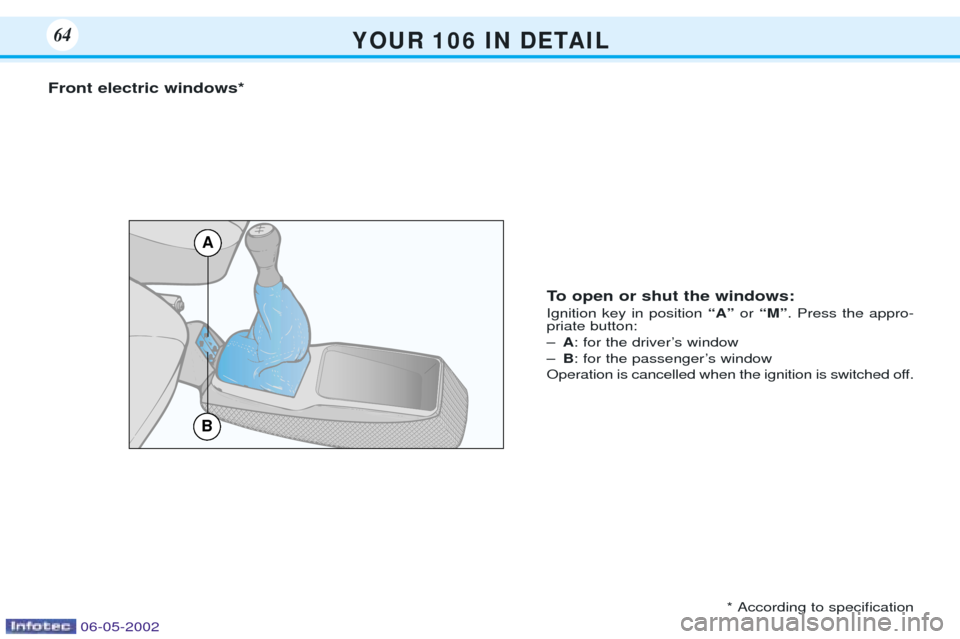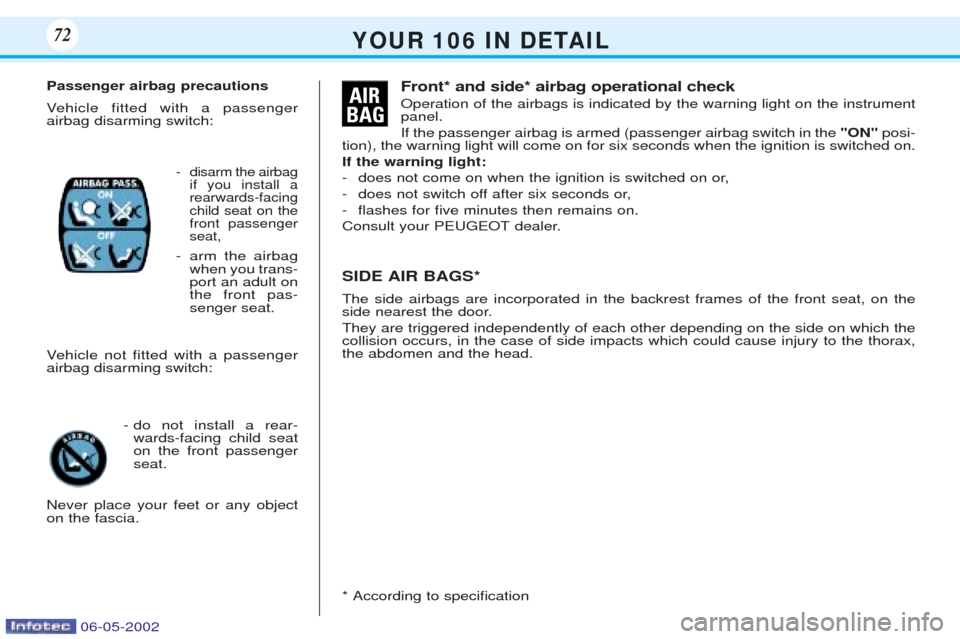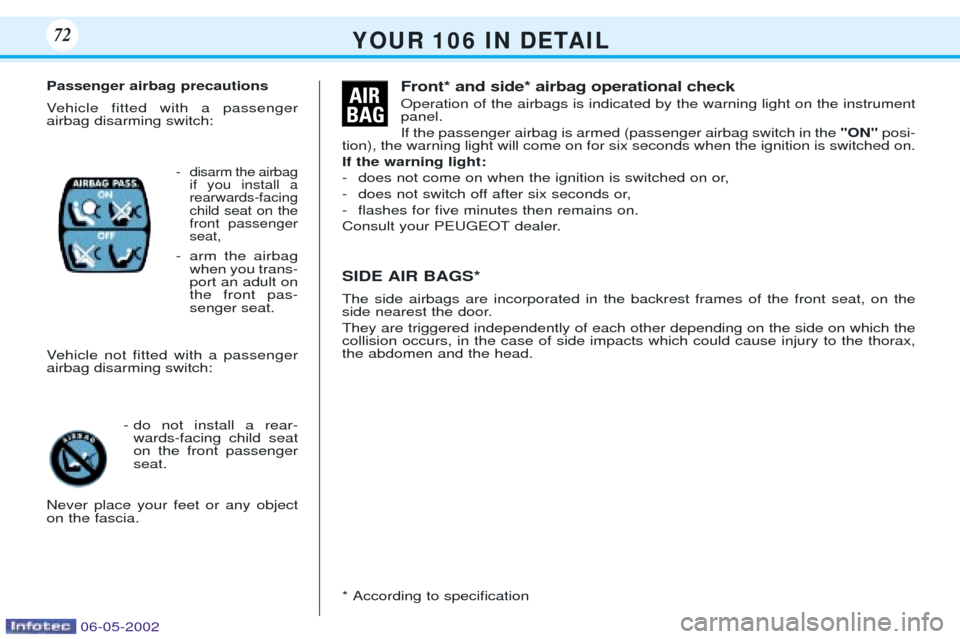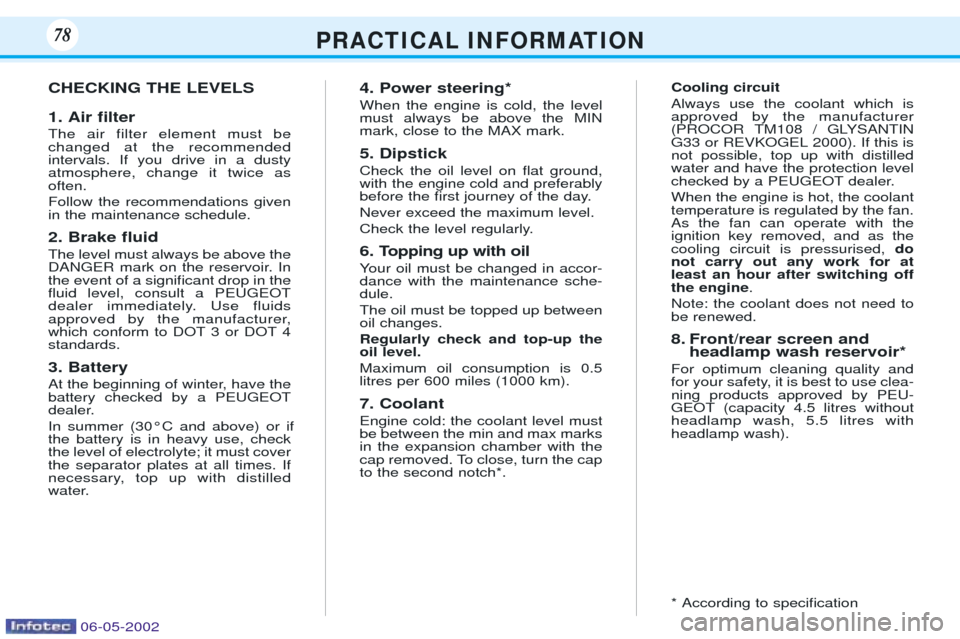2001.5 Peugeot 106 Dag ignition
[x] Cancel search: ignitionPage 66 of 107

FRONT WINDSCREEN WIPER Windscreen wiper stalk positions: 3High speed wipe
2 Normal speed wipe
1 Intermittent wipe
0 Stop
4 A single wipe
To operate the windscreen wash: Pull the wiper stalk towards you. REAR WINDSCREEN WIPER
To operate the rear screen wiper*:
- Turn the wiper stalk
A1/8 turn
forwards for intermittent or conti- nuous wipe*.
To operate the rear screenwash:
- Turn the wiper stalk a further 1/8 turn forwards.
Headlamp wash*
To operate the headlamp wash*:
- Switch the headlamps to dipped or main beam.
- Pull the wiper stalk towards you.This operates simultaneously with the windscreen wash/wipe. * According to speciÞcation Digital clock The time is set with the ignition on,
engine off, by pressing button
Bfor
more than 3 seconds. The hourswill then ßash.
To set the hours
- A short press, the hours change slowly.
- Press and hold, the hours change swiftly. To memorise the hour displayed, release thebutton for 5 seconds, the minuteswill then ßash.
To set the minutes
- A short press, the minutes change slowly.
- Press and hold, the minutes change swiftly. To memorise the minutes displayed, release thebutton for 5 seconds.
Y O U R 1 0 6 I N D E TA I L63
0
4
1
2
3
AB
06-05-2002
Page 67 of 107

Y O U R 1 0 6 I N D E TA I L64
A
B
Front electric windows*To open or shut the windows: Ignition key in position ÒAÓor ÒMÓ . Press the appro-
priate button: Ð A: for the driverÕs window
Ð B: for the passengerÕs window
Operation is cancelled when the ignition is switched off.
* According to speciÞcation
06-05-2002
Page 70 of 107

Heated seats*
Press the switch to operate the seat heating. Pressing it again stops the opera- tion. * According to speciÞcation
Lighting rheostat Adjustment can only be done with the engine running and the side-lights on, by pressing button
12on
the instrument panel, to increase ordecrease the instrument panel ligh-ting level.
Adjusting the headlamps
Depending on the load in your vehicle, it is recommended that theheadlamp beam is adjusted. 0- 1 or 2 people in the front seats.
Ð- 3 people.
1- 5 people.
2- 5 people + maximum authori- sed load.
3- Driver + maximum authorised load.
This adjustment can only be carriedout when the lighting control is inthe dipped/main beam position. Initial setting is position 0.
Hazard warning lights
The switch and the direction indica- tors ßash. Controls the direction indicators
simultaneously and continuously.
Use only in cases of danger, for an emergency stop or for driving inunusual conditions. Can operate with the ignition swit-
ched off.
Rear screen demister
Control for demisting the rearscreen (and exterior mirrors)*. Goes out automatically after approximately twelve minutes inorder to avoid excessive currentconsumption. Pushing it again restarts the opera- tion for twelve minutes.
Y O U R 1 0 6 I N D E TA I L67
06-05-2002
Page 72 of 107

Handbrake Application: When you have completed your parking manoeuvre, pull up thehandbrake to apply it.
To make application and release of
the handbrake easier, press thebrake pedal and pull the handbrakewith the engine running. Release: Press the button before releasing the handbrake.Anti-lock brake system(ABS)* In conjunction with approved tyres in good condition, the anti-lockbrake system improves the stabilityand handling of your 106, particu-larly on poor or slippery surfaces. The anti-lock brake system ope- rates automatically if there is a riskof wheel locking. Lighting of the ABS warning lamp may be due to the turning of awheel during an operation on thevehicle (changing a wheel, forexample) with the ignition on (posi-tion
M).
Note: In certain conditions, normal
operation of the system can berecognised by a light vibration ofthe brake pedal. Should an emergency stop be
necessary, press the brake pedal
Þrmly and continuously. Power steering*
This is a driving aid which offers the best compromise when parking andwhen driving at high speeds. Manual gearbox The gear positions are indicated on the gear lever knob.
1 - Reverse gear can only be
engaged with the vehicle stationary and the engineidling.
* According to speciÞcation.
Y O U R 1 0 6 I N D E TA I L70
1
06-05-2002
Page 73 of 107

AIR BAGS* The airbag system has been desi- gned to maximise the safety of theoccupants in the event of seriouscollisions. It works in conjunctionwith the seat belts. The electronic detectors register and analyse any abrupt deceleration ofthe vehicle; if the triggering thresholdis reached the airbags inßate instant-ly and come between the occupantsand the vehicle. Immediately after the impact, the air-
bags deßate rapidly, so that they donot hinder the visibility of the occu-pants and their exit if necessary fromthe vehicle. The airbags are not deployed in the case of collisions which are notserious, for which the seat belt is suf-Þcient to ensure maximum protec-tion. The seriousness of a collisiondepends on the nature of the obs-tacle and the speed of the vehicle atthe moment of the collision. Airbags only operate when the ignition is switched on. Note: the gas escaping from the
cushion can be a minor irritant. FRONT AIR BAGS* These are folded in the centre of the steering wheel for the driver and in
the fascia for the front passenger.They are deployed simultaneously(except in cases where the airbag isdisarmed), for frontal impacts wherethere is a risk of injury to the head orchest.
- Remove the ignition key, insert it
into the passenger airbag switch 1
and turn it to the ÒOFFÓposition.
- One of these two warning lights* on the instrumentpanel is lit throughout thedisarming process.
In the ÒOFFÓ position, the passenger
airbag will not be triggered in theevent of an impact. As soon as you remove the rearwards-facing child seat from thefront passenger seat, turn the airbagswitch to the ÒONÓ position, to armthe airbag and thus ensure thesafety of your passenger in animpact. * According to speciÞcation.
Disarming the passenger airbag*
To ensure the safety of your child, it is essential to disarm the pas-senger airbag when you install arearwards-facing child seat on thefront passenger seat.
Y O U R 1 0 6 I N D E TA I L71
1
AIR
BAG
06-05-2002
Page 74 of 107

Passenger airbag precautions
Vehicle fitted with a passenger airbag disarming switch:
- disarm the airbagif you install arearwards-facingchild seat on thefront passengerseat,
- arm the airbagwhen you trans-port an adult onthe front pas-senger seat.
Vehicle not fitted with a passengerairbag disarming switch:
- do not install a rear-wards-facing child seaton the front passengerseat.
Never place your feet or any objecton the fascia. Front* and side* airbag operational check Operation of the airbags is indicated by the warning light on the instrument panel. If the passenger airbag is armed (passenger airbag switch in the
"ON"posi-
tion), the warning light will come on for six seconds when the ignition is switched on. If the warning light:
- does not come on when the ignition is switched on or,
- does not switch off after six seconds or,
- ßashes for Þve minutes then remains on.
Consult your PEUGEOT dealer. SIDE AIR BAGS* The side airbags are incorporated in the backrest frames of the front seat, on the
side nearest the door. They are triggered independently of each other depending on the side on which the collision occurs, in the case of side impacts which could cause injury to the thorax,the abdomen and the head. * According to speciÞcation
Y O U R 1 0 6 I N D E TA I L72
06-05-2002
Page 76 of 107

Passenger airbag precautions
Vehicle fitted with a passenger airbag disarming switch:
- disarm the airbagif you install arearwards-facingchild seat on thefront passengerseat,
- arm the airbagwhen you trans-port an adult onthe front pas-senger seat.
Vehicle not fitted with a passengerairbag disarming switch:
- do not install a rear-wards-facing child seaton the front passengerseat.
Never place your feet or any objecton the fascia. Front* and side* airbag operational check Operation of the airbags is indicated by the warning light on the instrument panel. If the passenger airbag is armed (passenger airbag switch in the
"ON"posi-
tion), the warning light will come on for six seconds when the ignition is switched on. If the warning light:
- does not come on when the ignition is switched on or,
- does not switch off after six seconds or,
- ßashes for Þve minutes then remains on.
Consult your PEUGEOT dealer. SIDE AIR BAGS* The side airbags are incorporated in the backrest frames of the front seat, on the
side nearest the door. They are triggered independently of each other depending on the side on which the collision occurs, in the case of side impacts which could cause injury to the thorax,the abdomen and the head. * According to speciÞcation
Y O U R 1 0 6 I N D E TA I L72
06-05-2002
Page 82 of 107

P R A C T I C A L I N F O R M AT I O N7878
CHECKING THE LEVELS 1. Air Þlter The air filter element must be changed at the recommendedintervals. If you drive in a dustyatmosphere, change it twice asoften. Follow the recommendations given in the maintenance schedule. 2. Brake ßuid The level must always be above the
DANGER mark on the reservoir. Inthe event of a signiÞcant drop in theßuid level, consult a PEUGEOT
dealer immediately. Use fluids
approved by the manufacturer,which conform to DOT 3 or DOT 4standards. 3. Battery
At the beginning of winter, have the battery checked by a PEUGEOT
dealer. In summer (30¡C and above) or if the battery is in heavy use, checkthe level of electrolyte; it must coverthe separator plates at all times. If
necessary, top up with distilled
water.4. Power steering* When the engine is cold, the level must always be above the MINmark, close to the MAX mark. 5. Dipstick Check the oil level on ßat ground, with the engine cold and preferably
before the Þrst journey of the day. Never exceed the maximum level.
Check the level regularly.
6. Topping up with oil
Your oil must be changed in accor- dance with the maintenance sche-dule. The oil must be topped up between oil changes. Regularly check and top-up the oil level. Maximum oil consumption is 0.5 litres per 600 miles (1000 km). 7. Coolant Engine cold: the coolant level must be between the min and max marksin the expansion chamber with the
cap removed. To close, turn the capto the second notch*.
Cooling circuit Always use the coolant which is approved by the manufacturer
(PROCOR TM108 / GLYSANTING33 or REVKOGEL 2000). If this isnot possible, top up with distilledwater and have the protection level
checked by a PEUGEOT dealer. When the engine is hot, the coolant temperature is regulated by the fan.As the fan can operate with theignition key removed, and as thecooling circuit is pressurised,
do
not carry out any work for atleast an hour after switching offthe engine .
Note: the coolant does not need tobe renewed.
8. Front/rear screen and headlamp wash reservoir*
For optimum cleaning quality and
for your safety, it is best to use clea-ning products approved by PEU-GEOT (capacity 4.5 litres withoutheadlamp wash, 5.5 litres withheadlamp wash). * According to speciÞcation
06-05-2002